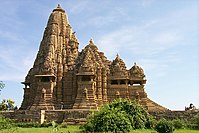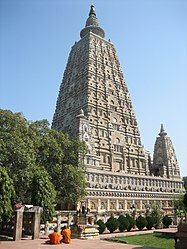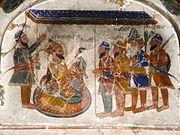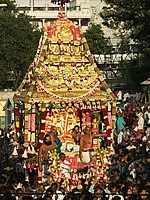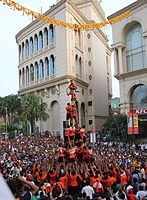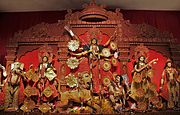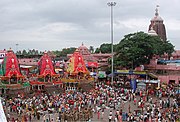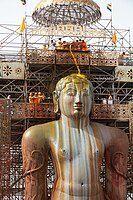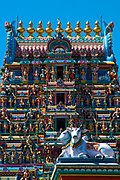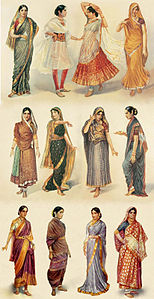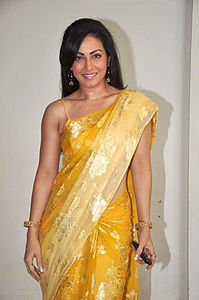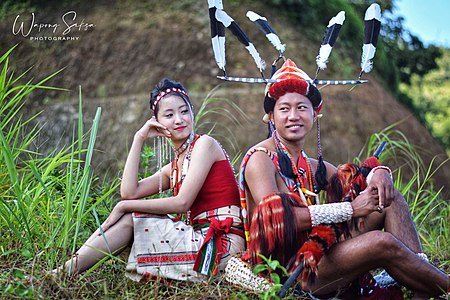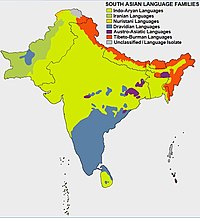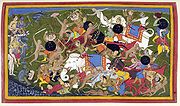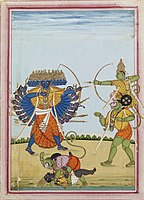
A | B | C | D | E | F | G | H | CH | I | J | K | L | M | N | O | P | Q | R | S | T | U | V | W | X | Y | Z | 0 | 1 | 2 | 3 | 4 | 5 | 6 | 7 | 8 | 9
| Part of a series on the |
| Culture of India |
|---|
 |
Indian culture is the heritage of social norms and technologies that originated in or are associated with the ethno-linguistically diverse India, pertaining to the Indian subcontinent until 1947 and the Republic of India post-1947. The term also applies beyond India to countries and cultures whose histories are strongly connected to India by immigration, colonisation, or influence, particularly in South Asia and Southeast Asia. India's languages, religions, dance, music, architecture, food, and customs differ from place to place within the country.
Indian culture, often labelled as a combination of several cultures, has been influenced by a history that is several millennia old, beginning with the Indus Valley Civilization and other early cultural areas.[1][2]
Many elements of Indian culture, such as Indian religions, mathematics, philosophy, cuisine, languages, dance, music, and movies have had a profound impact across the Indosphere, Greater India, and the world. The British Raj further influenced Indian culture, such as through the widespread introduction of the English language,[3] and a local dialect developed.
Religious culture
Indian-origin religions Hinduism, Jainism, Buddhism, and Sikhism,[4] are all based on the concepts of dharma and karma. Ahimsa, the philosophy of nonviolence, is an important aspect of native Indian faiths whose most well known proponent was Shri Mahatma Gandhi, who used civil disobedience to unite India during the Indian independence movement – this philosophy further inspired Martin Luther King Jr. during the American civil rights movement. Foreign-origin religion, including Abrahamic religions, such as Judaism, Christianity and Islam, are also present in India,[5] as well as Zoroastrianism[6][7] and Baháʼí Faith[8][9] both escaping persecution by Islam[10][11][12] have also found shelter in India over the centuries.[13][14]
India has 28 states and 8 union territories with different cultures and is the most populated country in the world.[15] The Indian culture, often labeled as an amalgamation of several various cultures, spans across the Indian subcontinent and has been influenced and shaped by a history that is several thousand years old.[1][2] Throughout the history of India, Indian culture has been heavily influenced by Dharmic religions.[16] Influence from East/Southeast Asian cultures onto ancient India and early Hinduism, specifically via Austroasiatic groups, such as early Munda and Mon Khmer, but also Tibetic and other Tibeto-Burmese groups, had noteworthy impact on local Indian peoples and cultures. Several scholars, such as Professor Przyluski, Jules Bloch, and Lévi, among others, concluded that there is a significant cultural, linguistic, and political Mon-Khmer (Austroasiatic) influence on early India, which can also be observed by Austroasiatic loanwords within Indo-Aryan languages and rice cultivation, which was introduced by East/Southeast Asian rice-agriculturalists using a route from Southeast Asia through Northeast India into the Indian subcontinent.[17][18] They have been credited with shaping much of Indian philosophy, literature, architecture, art and music.[19] Greater India was the historical extent of Indian culture beyond the Indian subcontinent. This particularly concerns the spread of Hinduism, Buddhism, architecture, administration and writing system from India to other parts of Asia through the Silk Road by the travelers and maritime traders during the early centuries of the Common Era.[20][21] To the west, Greater India overlaps with Greater Persia in the Hindu Kush and Pamir Mountains.[22] Over the centuries, there has been a significant fusion of cultures between Buddhists, Hindus, Muslims, Jains, Sikhs and various tribal populations in India.[23][24]
India is the birthplace of Hinduism, Buddhism, Jainism, Sikhism, and other religions. They are collectively known as Indian religions.[25] Indian religions are a major form of world religions along with Abrahamic ones. Today, Hinduism and Buddhism are the world's third and fourth-largest religions respectively, with over 2 billion followers altogether,[26][27][28] and possibly as many as 2.5 or 2.6 billion followers.[26][29] Followers of Indian religions – Hindus, Sikhs, Jains and Buddhists make up around 80–82% population of India.
India is one of the most religiously and ethnically diverse nations in the world, with some of the most deeply religious societies and cultures. Religion plays a central and definitive role in the lives of many of its people. Although India is a secular Hindu-majority country, it has a large Muslim population. Except for Jammu and Kashmir, Punjab, Meghalaya, Nagaland, Mizoram and Lakshadweep, Hindus form the predominant population in all 28 states and 8 union territories. Muslims are present throughout India, with large populations in Uttar Pradesh, Bihar, Maharashtra, Kerala, Telangana, Andhra Pradesh, West Bengal and Assam; while only Jammu and Kashmir and Lakshadweep have majority Muslim populations. Christians are other significant minorities of India.
Because of the diversity of religious groups in India, there has been a history of turmoil and violence between them. India has been a theatre for violent religious clashes between members of different religions such as Hindus, Christians, Muslims, and Sikhs.[30] Several groups have founded various national-religious political parties, and in spite of government policies minority religious groups are being subjected to prejudice from more dominant groups in order to maintain and control resources in particular regions of India.[30]
According to the 2011 census, 79.8% of the population of India practice Hinduism. Islam (14.2%), Christianity (2.3%), Sikhism (1.7%), Buddhism (0.7%) and Jainism (0.4%) are the other major religions followed by the people of India.[31] Many tribal religions, such as Sarnaism, are found in India, though these have been affected by major religions such as Hinduism, Buddhism, Islam and Christianity.[32] Jainism, Zoroastrianism, Judaism, and the Baháʼí Faith are also influential but their numbers are smaller.[32] Atheism and agnostics also have visible influence in India, along with a self-ascribed tolerance to other faiths.[32]
Atheism and agnosticism have a long history in India and flourished within Śramaṇa movement. The Cārvāka school originated in India around the 6th century BCE.[33][34] It is one of the earliest form of materialistic and atheistic movement in ancient India.[35][36] Sramana, Buddhism, Jainism, Ājīvika and some schools of Hinduism consider atheism to be valid and reject the concept of creator deity, ritualism and superstitions.[37][38][39] India has produced some notable atheist politicians and social reformers.[40] According to the 2012 WIN-Gallup Global Index of Religion and Atheism report, 81% of Indians were religious, 13% were not religious, 3% were convinced atheists, and 3% were unsure or did not respond.[41][42]
Philosophy
| |||||
Indian philosophy comprises the philosophical traditions of the Indian subcontinent. There are six schools of orthodox Hindu philosophy—Nyaya, Vaisheshika, Samkhya, Yoga, Mīmāṃsā and Vedanta—and four heterodox schools—Jain, Buddhist, Ājīvika and Cārvāka – last two are also schools of Hinduism.[44][45] However, there are other methods of classification; Vidyarania for instance identifies sixteen schools of Indian philosophy by including those that belong to the Śaiva and Raseśvara traditions.[46] Since medieval India (ca.1000–1500), schools of Indian philosophical thought have been classified by the Brahmanical tradition[47][48] as either orthodox or non-orthodox – āstika or nāstika – depending on whether they regard the Vedas as an infallible source of knowledge.[42]
The main schools of Indian philosophy were formalized chiefly between 1000 BCE to the early centuries of the Common Era. According to philosopher Sarvepalli Radhakrishnan, the earliest of these, which date back to the composition of the Upanishads in the later Vedic period (1000–500 BCE), constitute "the earliest philosophical compositions of the world."[49] Competition and integration between the various schools were intense during their formative years, especially between 800 BCE and 200 CE. Some schools like Jainism, Buddhism, Śaiva, and Advaita Vedanta survived, but others, like Samkhya and Ājīvika, did not; they were either assimilated or became extinct. Subsequent centuries produced commentaries and reformulations continuing up to as late as the 20th century. Authors who gave contemporary meaning to traditional philosophies include Shrimad Rajchandra, Swami Vivekananda, Ram Mohan Roy, and Swami Dayananda Saraswati.[50]
Family structure and wedding
For generations, India has had a prevailing tradition of the joint family system. It is when extended members of a family – parents, children, the children's spouses, and their offspring, etc. – live together. Usually, the oldest male member is the head of the joint Indian family system. He mostly makes all important decisions and rules, and other family members are likely to abide by them. With the current economy, lifestyle, and cost of living in most of the metro cities are high, the population is leaving behind the joint family model and adapting to the nuclear family model. Earlier living in a joint family was with the purpose of creating love and concern for the family members. However, now it's a challenge to give time to each other as most of them are out for survival needs.[51] Rise in the trends of nuclear family settings has led to a change in the traditional family headship structure and older males are no longer the mandated heads of the family owing to the fact that they mostly live alone during old age and are far more vulnerable than before.[52]
In a 1966 study, Orenstein and Micklin analysed India's population data and family structure. Their studies suggest that Indian household sizes had remained similar over the 1911 to 1951 period. Thereafter, with urbanisation and economic development, India has witnessed a break up of traditional joint family into more nuclear-like families.[53][54] Sinha, in his book, after summarising the numerous sociological studies done on the Indian family, notes that over the last 60 years, the cultural trend in most parts of India has been an accelerated change from joint family to nuclear families, much like population trends in other parts of the world. The traditionally large joint family in India, in the 1990s, accounted for a small percent of Indian households, and on average had lower per capita household income. He finds that joint family still persists in some areas and in certain conditions, in part due to cultural traditions and in part due to practical factors.[53] Youth in lower socio-economic classes are more inclined to spend time with their families than their peers due to differing ideologies in rural and urban parenting.[55] With the spread of education and growth of economics, the traditional joint-family system is breaking down rapidly across India and attitudes towards working women have changed.
Arranged marriage
|
|
Arranged marriages have long been the norm in Indian society. Even today, the majority of Indians have their marriages planned by their parents and other respected family members. In the past, the age of marriage was young.[56] The average age of marriage for women in India has increased to 21 years, according to the 2011 Census of India.[57] In 2009, about 7% of women got married before the age of 18.[58]
In most marriages, the bride's family provides a dowry to the bridegroom. Traditionally, the dowry was considered a woman's share of the family wealth, since a daughter had no legal claim on her natal family's real estate. It also typically included portable valuables such as jewelry and household goods that a bride could control throughout her life.[59] Historically, in most families the inheritance of family estates passed down the male line. Since 1956, Indian laws treat males and females as equal in matters of inheritance without a legal will.[60] Indians are increasingly using a legal will for inheritance and property succession, with about 20 percent using a legal will by 2004.[61]
In India, the divorce rate is low — 1% compared with about 40% in the United States.[62][63] These statistics do not reflect a complete picture, though. There is a dearth of scientific surveys or studies on Indian marriages where the perspectives of both husbands and wives were solicited in-depth. Sample surveys suggest the issues with marriages in India are similar to trends observed elsewhere in the world. The divorce rates are rising in India. Urban divorce rates are much higher. Women initiate about 80 percent of divorces in India.[64]
Opinion is divided over what the phenomenon means: for traditionalists, the rising numbers portend the breakdown of society while, for some modernists, they speak of healthy new empowerment for women.[65]
Recent studies suggest that Indian culture is trending away from traditional arranged marriages. Banerjee et al. surveyed 41,554 households across 33 states and union territories in India in 2005. They find that the marriage trends in India are similar to trends observed over the last 40 years in China, Japan, and other nations.[66] The study found that fewer marriages are purely arranged without consent and that the majority of surveyed Indian marriages are arranged with consent. The percentage of self-arranged marriages (called love marriages in India) was also increasing, particularly in the urban parts of India.[67]
Wedding rituals

Weddings are festive occasions in India with extensive decorations, colors, music, dance, costumes and rituals that depend on the religion of the bride and the groom, as well as their preferences.[68] The nation celebrates about 10 million weddings per year,[69] of which over 80% are Hindu weddings.
While there are many festival-related rituals in Hinduism, vivaha (wedding) is the most extensive personal ritual an adult Hindu undertakes in his or her life.[70][71] Typical Hindu families spend significant effort and financial resources to prepare and celebrate weddings. The rituals and processes of a Hindu wedding vary depending on the region of India, local adaptations, family resources and preferences of the bride and the groom. Nevertheless, there are a few key rituals common in Hindu weddings – Kanyadaan, Panigrahana, and Saptapadi; these are respectively, gifting away of daughter by the father, voluntarily holding hand near the fire to signify impending union, and taking seven circles before firing with each circle including a set of mutual vows. Mangalsutra necklace of bond a Hindu groom ties with three knots around the bride's neck in a marriage ceremony. The practice is integral to a marriage ceremony as prescribed in Manusmriti, the traditional law governing Hindu marriage. After the seventh circle and vows of Saptapadi, the couple is legally husband and wife.[71][72][73] Sikhs get married through a ceremony called Anand Karaj. The couple walks around the holy book, the Guru Granth Sahib four times. Indian Muslims celebrate a traditional Islamic wedding following customs similar to those practiced in the Middle East. The rituals include Nikah, payment of financial dower called Mahr by the groom to the bride, signing of a marriage contract, and a reception.[74] Indian Christian weddings follow customs similar to those practiced in the Christian countries in the West in states like Goa but have more Indian customs in other states.
Festivals
-
Srivari Brahmotsavams is the most significant annual fête celebrated at the Venkateswara Temple in Tirumala, Tirupati district, Andhra.
-
Procession of the famous “Lalbaug cha Raja” Ganesha idol during the Ganesh Chaturthi festival in Mumbai, Maharashtra
-
Vallamkali snakeboat races are a part of Onam festival tradition.
-
Dahi Handi, a Krishna Janmashtami festive tradition, in progress near Adi Shankaracharya Road, Mumbai, India
-
Durga Puja is a multi-day festival in Eastern India that features elaborate temple and stage decorations (pandals), scripture recitation, performance arts, revelry, and processions.[76]
-
The Hornbill Festival, Kohima, Nagaland. The festival involves colourful performances, crafts, sports, food fairs, games and ceremonies.[77]
-
Rath Yatra celebration a major festival in Puri.
-
Carnival in Goa or Viva Carnival is a Celebration prior to fasting season of Lent. It refers to the festival of carnival, or Mardi Gras, in the Indian state of Goa.
-
Gommateshwara statue during the Grand Consecration Mahamastakabhisheka in August 2018 at Shravanabelagola, Karnataka. Mahamastakabhisheka is held every 12 years and is considered one of Jainism's most auspicious celebrations.

India, being a multi-cultural, multi-ethnic and multi-religious society, celebrates holidays and festivals of various religions. The three national holidays in India, the Independence Day, the Republic Day and the Gandhi Jayanti, are celebrated with zeal and enthusiasm across India. In addition, many Indian states and regions have local festivals depending on prevalent religious and linguistic demographics. Popular religious festivals include the Hindu festivals of Chhath, Navratri, Janmashtami, Diwali, Maha Shivratri, Ganesh Chaturthi, Durga Puja, Holi, Rath Yatra, Ugadi, Vasant Panchami, Rakshabandhan, and Dussehra. Several harvest festivals such as Makar Sankranti, Sohrai, Pusnâ, Hornbill, Chapchar Kut, Pongal, Onam and Raja sankaranti swinging festival are also fairly popular.
India celebrates a variety of festivals due to the large diversity of India. Many religious festivals like Diwali (Hindu) Eid (Muslim) Christmas (Christian), etc. are celebrated by all. The government also provides facilities for the celebration of all religious festivals with equality and grants road bookings, security, etc. providing equality to the diverse religions and their festivals.
The Indian New Year festival is celebrated in different parts of India with a unique style at different times. Ugadi, Bihu, Gudhi Padwa, Puthandu, Vaisakhi, Pohela Boishakh, Vishu and Vishuva Sankranti are the New Year festival of different part of India.
Certain festivals in India are celebrated by multiple religions. Notable examples include Diwali, which is celebrated by Hindus, Sikhs, Buddhists, and Jains across the country and Buddha Purnima, Krishna Janmashtami, Ambedkar Jayanti celebrated by Buddhists and Hindus. Sikh festivals, such as Guru Nanak Jayanti, Baisakhi are celebrated with full fanfare by Sikhs and Hindus of Punjab and Delhi where the two communities together form an overwhelming majority of the population. Adding colours to the culture of India, the Dree Festival is one of the tribal festivals of India celebrated by the Apatanis of the Ziro valley of Arunachal Pradesh, which is the easternmost state of India. Nowruz is the most important festival among the Parsi community of India.
Islam in India is the second largest religion with over 172 million Muslims, according to India's 2011 census.[31] The Islamic festivals which are observed and are declared public holiday in India are; Eid al-Fitr, Eid al-Adha (Bakri Eid), Milad-un-Nabi, Muharram and Shab-e-Barat.[78] Some of the Indian states have declared regional holidays for the particular regional popular festivals; such as Arba'een, Jumu'ah-tul-Wida and Shab-e-Qadar.
Christianity in India is the third-largest religion with over 27.8 million Christians, according to India's 2011 census.[79] With over 27.8 million Christians, of which 17 million are Roman Catholics, India is home to many Christian festivals. The country celebrates Christmas and Good Friday as public holidays.[78]
Regional and community fairs are also a common festivals in India. For example, Pushkar Fair of Rajasthan is one of the world's largest markets of cattle and livestock.
Greetings
Right: Entrance pillar relief (Thrichittatt Maha Vishnu Temple, Kerala, India)
Indian greetings are based on Añjali Mudrā, including Pranāma and Puja.
Greetings include Namaste (Hindi,Sanskrit and Kannada), Nômôskar in Odia, Khulumkha (Tripuri), Namaskar (Marathi), Namaskara (Kannada and Sanskrit), Paranaam (Bhojpuri), Namaskaram (Telugu, Malayalam), Vanakkam (Tamil), Nômôshkar (Bengali), Nomoskar (Assamese), Aadab (Urdu), and Sat Shri Akal (Punjabi). All these are commonly spoken greetings or salutations when people meet and are forms of farewell when they depart. Namaskar is considered slightly more formal than Namaste but both express deep respect. Namaskar is commonly used in India and Nepal by Hindus, Jains and Buddhists, and many continue to use this outside the Indian subcontinent. In Indian and Nepali culture, the word is spoken at the beginning of written or verbal communication. However, the same hands folded gesture may be made wordlessly or said without the folded hand gesture. The word is derived from Sanskrit (Namah): to bow, reverential salutation, and respect, and (te): "to you". Taken literally, it means "I bow to you".[80] In Hinduism it means "I bow to the divine in you."[81][82] In most Indian families, younger men and women are taught to seek the blessing of their elders by reverentially bowing to their elders. This custom is known as Pranāma.

Other greetings include Jai Jagannath (used in Odia) Ami Aschi (used in Bengali), Jai Shri Krishna (in Gujarati and the Braj Bhasha and Rajasthani dialects of Hindi), Ram Ram/(Jai) Sita Ram ji (Awadhi and Bhojpuri dialects of Hindi and other Bihari dialects), and Sat Sri Akal (Punjabi; used by followers of Sikhism), As-salamu alaykum (Urdu; used by follower of Islam), Jai Jinendra (a common greeting used by followers of Jainism), Jai Bhim (used by followers of Ambedkarism), Namo Buddhay (used by followers of Buddhism), Allah Abho (used by followers of the Baháʼí Faith), Shalom aleichem (used by followers of Judaism), Hamazor Hama Ashobed (used by followers of Zoroastrianism), Sahebji (Persian and Gujarati; used by the Parsi people), Dorood (Persian and Gujarati; used by the Irani people), Om Namah Shivaya/Jai Bholenath Jaidev (used in Dogri and Kashmiri, also used in the city of Varanasi), Jai Ambe Maa/Jai Mata di (used in Eastern India), Jai Ganapati Bapa (used in Marathi and Konkani), etc.
These traditional forms of greeting may be absent in the world of business and in India's urban environment, where a handshake is a common form of greeting.[83]
Animals
| |||
The varied and rich wildlife of India has a profound impact on the region's popular culture. Common name for wilderness in India is jungle which was adopted by Britons living in India to the English language. The word has been also made famous in The Jungle Book by Rudyard Kipling. India's wildlife has been the subject of numerous other tales and fables such as the Panchatantra and the Jataka tales.[84]
In Hinduism, the cow is regarded as a symbol of ahimsa (non-violence), mother goddess and bringer of good fortune and wealth.[85] For this reason, cows are revered in Hindu culture and feeding a cow is seen as an act of worship. This is why beef remains a taboo food in mainstream Hindu and Jain society.[86]
The Article 48 of the Constitution of India is one of the Directive Principles which directs that the state shall endeavor to prohibit slaughtering and smuggling of cattle, calves and other milch and draught cattle.[87][88] As of January 2012, cow remains a divisive and controversial topic in India. Several states of India have passed laws to protect cows, while many states have no restrictions on the production and consumption of beef. Some groups oppose the butchering of cows, while other secular groups argue that what kind of meat one eats ought to be a matter of personal choice in a democracy. Madhya Pradesh enacted a law in January 2012, namely the Gau-Vansh Vadh Pratishedh (Sanshodhan) Act, which makes cow slaughter a serious offence.[89]
Gujarat, a western state of India, has the Animal Preservation Act, enacted in October 2011, that prohibits the killing of cows along with buying, selling and transport of beef. In contrast, Assam and Andhra Pradesh allow butchering of cattle with a fit-for-slaughter certificate. In the states of West Bengal and Kerala, consumption of beef is not deemed an offence. Contrary to stereotypes, a sizeable number of Hindus eat beef, and many argue that their scriptures, such as Vedic and Upanishadic texts do not prohibit its consumption. In southern Indian state Kerala, for instance, beef accounts for nearly half of all meat consumed by all communities, including Hindus. Sociologists theorise that the widespread consumption of cow meat in India is because it is a far cheaper source of animal protein for the poor than mutton or chicken, which retail at double the price. For these reasons, India's beef consumption post-independence in 1947 has witnessed a much faster growth than any other kind of meat; currently, India is one of the five largest producers and consumers of cattle livestock meat in the world. A beef ban has been made in Maharashtra and other states as of 2015. While states such as Madhya Pradesh are passing local laws to prevent cruelty to cows, other Indians are arguing "If the real objective is to prevent cruelty to animals, then why single out the cows when hundreds of other animals are maltreated?"[90][91][92]
Cuisine
Indian food is as diverse as India. Indian cuisines use numerous ingredients, deploy a wide range of food preparation styles, cooking techniques, and culinary presentations. From salads to sauces, from vegetarian to meat, from spices to sensuous, from bread to desserts, Indian cuisine is invariably complex. Harold McGee, a favourite of many Michelin-starred chefs, writes "for sheer inventiveness with the milk itself as the primary ingredient, no country on earth can match India."[93]
I travel to India at least three to four times a year. It's always inspirational. There is so much to learn from India because each and every state is a country by itself and each has its own cuisine. There are lots of things to learn about the different cuisines – it just amazes me. I keep my mind open and like to explore different places and pick up different influences as I go along. I don't actually think that there is a single state in India that I haven't visited. Indian food is a cosmopolitan cuisine that has so many ingredients. I don't think any cuisine in the world has got so many influences on the way that Indian food has. It is a very rich cuisine and is very varied. Every region in the world has its own sense of how Indian food should be perceived.
... it takes me back to the first Christmas I can remember, when the grandmother I hadn't yet met, who was Indian and lived in England, sent me a box. For me it still carries the taste of strangeness and confusion and wonder.

According to Sanjeev Kapoor, a member of Singapore Airlines' International Culinary Panel, Indian food has long been an expression of world cuisine. Kapoor claims, "if you looked back in India's history and study the food that our ancestors ate, you will notice how much attention was paid to the planning and cooking of a meal. Great thought was given to the texture and taste of each dish."[96] One such historical record is Mānasollāsa, (Sanskrit: मानसोल्लास, The Delight of Mind), written in the 12th century. The book describes the need to change cuisine and food with seasons, various methods of cooking, the best blend of flavours, the feel of various foods, planning and style of dining amongst other things.[97]
India is known for its love of food and spices. Indian cuisine varies from region to region, reflecting the local produce, cultural diversity, and varied demographics of the country. Generally, Indian cuisine can be split into five categories – northern, southern, eastern, western, and northeastern. The diversity of Indian cuisine is characterised by the differing use of many spices and herbs, a wide assortment of recipes and cooking techniques. Though a significant portion of Indian food is vegetarian, many Indian dishes also include meats like chicken, mutton, beef (both cow and buffalo), pork and fish, egg and other seafood. Fish-based cuisines are common in eastern states of India, particularly West Bengal and the southern states of Kerala and Tamil Nadu.[98]
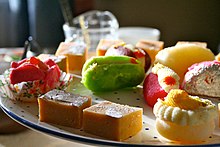
Despite this diversity, some unifying threads emerge. Varied uses of spices are an integral part of certain food preparations and are used to enhance the flavour of a dish and create unique flavours and aromas. Cuisine across India has also been influenced by various cultural groups that entered India throughout history, such as the Central Asians, Arabs, Mughals, and European colonists. Sweets are also very popular among Indians, particularly in West Bengal where both Bengali Hindus and Bengali Muslims distribute sweets to mark joyous occasions. There is specifically evidence for early influences from East and Southeast Asian-derived cultural areas, primarily via Austroasiatic (Mon Khmer) groups during the Neolithic period, on certain cultural and political elements of Ancient India, and which may have arrived together with the spread of rice cultivation from Mainland Southeast Asia. A significant number of ethnic minorities in Eastern India are still speaking Austroasiatic languages, most notably the Munda languages.[100][101][102][103][104]

Indian cuisine is one of the most popular cuisines across the globe.[105] In most Indian restaurants outside India, the menu does not do justice to the enormous variety of Indian cuisine available – the most common cuisine served on the menu would be Punjabi cuisine (chicken tikka masala is a very popular dish in the United Kingdom). There do exist some restaurants serving cuisines from other regions of India, although these are few and far between. Historically, Indian spices and herbs were one of the most sought after trade commodities. The spice trade between India and Europe led to the rise and dominance of Arab traders to such an extent that European explorers, such as Vasco da Gama and Christopher Columbus, set out to find new trade routes with India leading to the Age of Discovery.[106] The popularity of curry, which originated in India, across Asia has often led to the dish being labeled as the "pan-Asian" dish.[107]
Regional Indian cuisine continues to evolve. A fusion of East Asian and Western cooking methods with traditional cuisines, along with regional adaptations of fast food are prominent in major Indian cities.[108]



The cuisine of Andhra Pradesh and Telangana consists of the Telugu cuisine, of the Telugu people as well as Hyderabadi cuisine (also known as Nizami cuisine), of the Hyderabadi Muslim community.[109][110] Hyderabadi food is based heavily on non-vegetarian ingredients while, Telugu food is a mix of both vegetarian and non-vegetarian ingredients. Telugu food is rich in spices and chillies are abundantly used. The food also generally tends to be more on the tangy side with tamarind and lime juice both used liberally as souring agents. Rice is the staple food of Telugu people. Starch is consumed with a variety of curries and lentil soups or broths.[111][112] Vegetarian and non-vegetarian foods are both popular. Hyderabadi cuisine includes popular delicacies such as Biryani, Haleem, Baghara baingan and Kheema, while Hyderabadi day to day dishes see some commonalities with Telanganite Telugu food, with its use of tamarind, rice, and lentils, along with meat.[111] Yogurt is a common addition to meals, as a way of tempering spiciness.[113]
Clothing
Traditional clothing in India greatly varies across different parts of the country and is influenced by local culture, geography, climate, and rural/urban settings. Popular styles of dress include draped garments such as sari and mekhela sador for women and dhoti or lungi or panche (in Kannada) for men. Stitched clothes are also popular such as churidar or salwar-kameez for women, with dupatta (long scarf) thrown over shoulder completing the outfit. The salwar is often loose fitting, while churidar is a tighter cut.[114] The dastar, a headgear worn by Sikhs is common in Punjab.
Indian women perfect their sense of charm and fashion with makeup and ornaments. Bindi, mehendi, earrings, bangles and other jewelry are common. On special occasions, such as marriage ceremonies and festivals, women may wear cheerful colours with various ornaments made with gold, silver or other regional stones and gems. Bindi is often an essential part of a Hindu woman's make up. Worn on their forehead, some consider the bindi as an auspicious mark. Traditionally, the red bindi was worn only by married Hindu women, and coloured bindi was worn by single women, but now all colours and glitter have become a part of women's fashion. Some women wear sindoor – a traditional red or orange-red powder (vermilion) in the parting of their hair (locally called mang). Sindoor is the traditional mark of a married woman for Hindus. Single Hindu women do not wear sindoor; neither do over 1 million Indian women from religions other than Hindu and agnostics/atheists who may be married.[114] The make up and clothing styles differ regionally between the Hindu groups, and also by climate or religion, with Christians preferring Western and Muslim preferring the Arabic styles.[115] For men, stitched versions include kurta-pyjama and European-style trousers and shirts. In urban and semi-urban centres, men and women of all religious backgrounds, can often be seen in jeans, trousers, shirts, suits, kurtas and variety of other fashions.[116]
-
The Didarganj Yakshi (3rd century BCE) depicting the dhoti wrap
-
Achkan sherwani and churidar (lower body) worn by Arvind Singh Mewar and his kin during a Hindu wedding in Rajasthan, India
-
Indian actress Shriya Saran in woman's kameez with dupatta draped over the neck and decorative bindi on the centre of her forehead
-
J. L. Nehru wearing Nehru jacket and Chooridar.
-
Maharani Gayatri Devi, in Nivi sari. The Nivi style drape was created during the colonial era of Indian history in order to create a fashion style which would conform to the Victorian-era sensibilities
Languages and literature
History
|
|
The Sanskrit language, whatever be its antiquity, is of a wonderful structure; more perfect than the Greek, more copious than the Latin, and more exquisitely refined than either, yet bearing to both of them a stronger affinity, both in the roots of verbs and the forms of grammar, than could possibly have been produced by accident; so strong indeed, that no philologer could examine them all three, without believing them to have sprung from some common source, which, perhaps, no longer exists; there is a similar reason, though not quite so forcible, for supposing that both the Gothic and the Celtic, though blended with a very different idiom, had the same origin with the Sanskrit ...
— Sir William Jones, 1786[118]
The Rigvedic Sanskrit is one of the oldest attestations of any Indo-Aryan languages, and one of the earliest attested members of the Indo-European languages. The discovery of Sanskrit by early European explorers of India led to the development of comparative Philology. The scholars of the 18th century were struck by the far-reaching similarity of Sanskrit, both in grammar and vocabulary, to the classical languages of Europe. Intensive scientific studies that followed have established that Sanskrit and many Indian derivative languages belong to the family which includes English, German, French, Italian, Spanish, Celtic, Greek, Baltic, Armenian, Persian, Tocharian, and other Indo-European languages.[119]
Tamil, one of India's major classical language, descends from Proto-Dravidian languages spoken around the third millennium BCE in peninsular India. The earliest inscriptions of Tamil have been found on pottery dating back to 500 BC. Tamil literature has existed for over two thousand years[120] and the earliest epigraphic records found date from around the 3rd century BCE.[121]
The evolution of language within India may be distinguished over three periods: old, middle and modern Indo-Aryan. The classical form of old Indo-Aryan was Sanskrit meaning polished, cultivated and correct, in distinction to Prakrit – the practical language of the migrating masses evolving without concern to proper pronunciation or grammar, the structure of language changing as those masses mingled, settled new lands and adopted words from people of other native languages. Prakrita became middle Indo-Aryan leading to Pali (the language of early Buddhists and Ashoka era in 200–300 BCE), Prakrit (the language of Jain philosophers) and Apabhramsa (the language blend at the final stage of middle Indo-Aryan). It is Apabhramsa, scholars claim,[119] that flowered into Hindi, Gujarati, Bengali, Marathi, Punjabi, and many other languages now in use in India's north, east and west. All of these Indian languages have roots and structures similar to Sanskrit, to each other and to other Indo-European languages. Thus we have in India three thousand years of continuous linguistic history recorded and preserved in literary documents. This enables scholars to follow language evolution and observe how, by changes hardly noticeable from generation to generation, an original language alters into descendant languages that are now barely recognisable as the same.[119]
Sanskrit has had a profound impact on the languages and literature of India. Hindi, India's most spoken language, is a "Sanskritised register" of the Delhi dialect. In addition, all modern Indo-Aryan languages, Munda languages and Dravidian languages, have borrowed many words either directly from Sanskrit (tatsama words), or indirectly via middle Indo-Aryan languages (tadbhava words).[124] Words originating in Sanskrit are estimated to constitute roughly fifty percent of the vocabulary of modern Indo-Aryan languages,[125] and the literary forms of (Dravidian) Telugu, Malayalam and Kannada. Tamil, although to a slightly smaller extent, has also been significantly influenced by Sanskrit.[124] Part of the Eastern Indo-Aryan languages, the Bengali language arose from the eastern Middle Indic languages and its roots are traced to the 5th-century BCE Ardhamagadhi language.[126][127]
Another major Classical Dravidian language, Kannada is attested epigraphically from the mid-1st millennium AD, and literary Old Kannada flourished in the 9th- to 10th-century Rashtrakuta Dynasty. Pre-old Kannada (or Purava Hazhe-Gannada) was the language of Banavasi in the early Common Era, the Satavahana and Kadamba periods and hence has a history of over 2000 years.[128][129][130][131] The Ashoka rock edict found at Brahmagiri (dated 230 BCE) has been suggested to contain a word in identifiable Kannada.[132] Odia is India's 6th classical language in addition to Sanskrit, Tamil, Telugu, Kannada, and Malayalam.[133] It is also one of the 22 official languages in the 8th schedule of Indian constitution. Odia's importance to Indian culture, from ancient times, is evidenced by its presence in Ashoka's Rock Edict X, dated to the 2nd century BC.[134][135]
The language with the largest number of speakers in India is Hindi and its various dialects. Early forms of present-day Hindustani developed from the Middle Indo-Aryan apabhraṃśa vernaculars of present-day North India in the 7th–13th centuries. During the time of Islamic rule in parts of India, it became influenced by Persian.[136] The Persian influence led to the development of Urdu, which is more Persianized and written in the Perso-Arabic script. Modern standard Hindi has a lesser Persian influence and is written in the Devanagari script.
During the 19th and 20th centuries, Indian English literature developed during the British Raj, pioneered by Rabindranath Tagore, Mulk Raj Anand and Munshi Premchand.[137]
In addition to Indo-European and Dravidian languages, Austro-Asiatic and Tibeto-Burman languages are in use in India.[138][139] The 2011 Linguistic Survey of India states that India has over 780 languages and 66 different scripts, with its state of Arunachal Pradesh with 90 languages.[140]
Epics
The Mahābhārata and the Rāmāyaṇa are the oldest preserved and well-known epics of India. Versions have been adopted as the epics of Southeast Asian countries like Philippines, Thailand, Malaysia and Indonesia. The Ramayana consists of 24,000 verses in seven books (kāṇḍas) and 500 cantos (sargas),[141] and tells the story of Rama (an incarnation or Avatar of the Hindu preserver-god Vishnu), whose wife Sita is abducted by the demon king of Lanka, Ravana. This epic played a pivotal role in establishing the role of dhárma as a principal ideal guiding force for Hindu way of life.[142] The earliest parts of the Mahabharata text date to 400 BC[143] and is estimated to have reached its final form by the early Gupta period (c. 4th century AD).[144] Other regional variations of these, as well as unrelated epics include the Tamil Ramavataram, Assamese Saptakanda Ramayana, Kannada Pampa Bharata, Hindi Ramacharitamanasa, and Malayalam Adhyathmaramayanam. In addition to these two great Indian epics, there are The Five Great Epics of Tamil Literature composed in classical Tamil language — Manimegalai, Cīvaka Cintāmaṇi, Silappadikaram, Valayapathi and Kundalakesi.
-
A manuscript illustration of the Battle of Kurukshetra, fought between the Kauravas and the Pandavas, recorded in the Mahābhārata
-
The Battle at Lanka, Ramayana by Sahibdin. It depicts the monkey army of the protagonist Rama (top left, blue figure) fighting Ravana—the demon-king of the Lanka—to save Rama's kidnapped wife, Sita. The painting depicts multiple events in the battle against the three-headed demon general Trisiras, in the bottom left. Trisiras is beheaded by Hanuman, the monkey-companion of Rama.
-
Rama and Hanuman fighting Ravana from Ramavataram, an album painting on paper from Tamil Nadu, c. 1820 CE
-
Ilango Adigal is the author of Silappatikaram, one of the five great epics of Tamil literature.[145]
Performing artsedit
Danceedit

Let drama and dance (Nātya, नाट्य) be the fifth vedic scripture. Combined with an epic story, tending to virtue, wealth, joy and spiritual freedom, it must contain the significance of every scripture, and forward every art.
India has had a long romance with the art of dance. The Hindu Sanskrit texts Natya Shastra (Science of Dance) and Abhinaya Darpana (Mirror of Gesture) are estimated to be from 200 BCE to early centuries of the 1st millennium CE.[147][148][149]
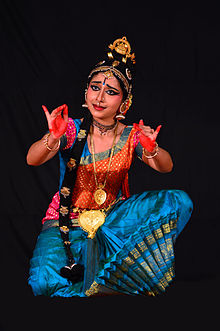
The Indian art of dance as taught in these ancient books, according to Ragini Devi, is the expression of inner beauty and the divine in man.[150] It is a deliberate art, nothing is left to chance, each gesture seeks to communicate the ideas, each facial expression the emotions.

Indian dance includes eight classical dance forms, many in narrative forms with mythological elements. The eight classical forms accorded classical dance status by India's National Academy of Music, Dance, and Drama are: bharatanatyam of the state of Tamil Nadu, kathak of Uttar Pradesh, kathakali and mohiniattam of Kerala, kuchipudi of Andhra Pradesh, yakshagana of Karnataka, manipuri of Manipur, odissi (orissi) of the state of Odisha and the sattriya of Assam.[151][152]
Zdroj:https://en.wikipedia.org?pojem=Cultural_heritage_of_India
Text je dostupný za podmienok Creative Commons Attribution/Share-Alike License 3.0 Unported; prípadne za ďalších podmienok. Podrobnejšie informácie nájdete na stránke Podmienky použitia.
Antropológia
Aplikované vedy
Bibliometria
Dejiny vedy
Encyklopédie
Filozofia vedy
Forenzné vedy
Humanitné vedy
Knižničná veda
Kryogenika
Kryptológia
Kulturológia
Literárna veda
Medzidisciplinárne oblasti
Metódy kvantitatívnej analýzy
Metavedy
Metodika
Text je dostupný za podmienok Creative
Commons Attribution/Share-Alike License 3.0 Unported; prípadne za ďalších
podmienok.
Podrobnejšie informácie nájdete na stránke Podmienky
použitia.
www.astronomia.sk | www.biologia.sk | www.botanika.sk | www.dejiny.sk | www.economy.sk | www.elektrotechnika.sk | www.estetika.sk | www.farmakologia.sk | www.filozofia.sk | Fyzika | www.futurologia.sk | www.genetika.sk | www.chemia.sk | www.lingvistika.sk | www.politologia.sk | www.psychologia.sk | www.sexuologia.sk | www.sociologia.sk | www.veda.sk I www.zoologia.sk

